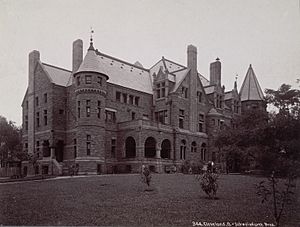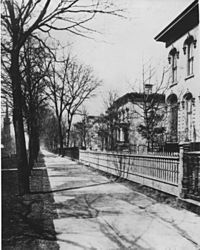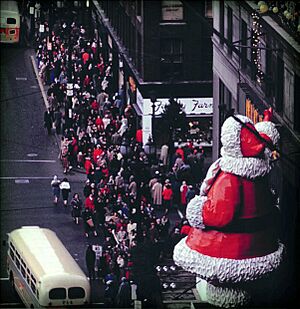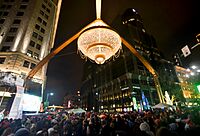Euclid Avenue (Cleveland) facts for kids
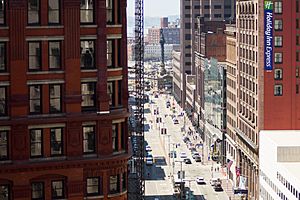
Looking westbound on Euclid Avenue from above E. 9th Street and the Schofield Building. The Soldiers' and Sailors' Monument can be seen in the distance.
|
|
| Part of | |
|---|---|
| Length | 18.9 mi (30.4 km) |
| Location | Cleveland, Ohio |
| West end | |
| Major junctions |
|
| East end | |
| Construction | |
| Commissioned | 1815 |
Euclid Avenue is a very important street in Cleveland, Ohio, United States. It starts at Public Square in Downtown Cleveland. From there, it goes northeast past places like Playhouse Square and Cleveland State University. It also passes University Circle, the Cleveland Clinic, and Case Western Reserve University.
The street continues through the towns of East Cleveland, Euclid, and Wickliffe. It ends in Willoughby. Parts of Euclid Avenue are also known as U.S. Route 20 and U.S. Route 6. A special bus line called the HealthLine runs in its own lanes down the middle of Euclid Avenue. This line goes from Public Square to Louis Stokes Station at Windermere in East Cleveland.
From the 1860s to the 1920s, Euclid Avenue was famous across the country. People loved its beauty and the many rich families who lived there. Their large homes were known as Millionaires' Row. Today, you can still find theaters, banks, and churches along Euclid Avenue. Cleveland's oldest building, the Dunham Tavern, is also there.
Contents
What Was Millionaires' Row?
In the late 1800s and early 1900s, Euclid Avenue was known around the world. Travel guides like Baedeker's called it "The Showplace of America." They said it was a must-see for visitors from Europe. The street had so much wealth that the value of its mansions was more than those on New York's Fifth Avenue. People at the time compared it to famous streets like the Avenue des Champs-Élysées in Paris. They also compared it to the Unter den Linden in Berlin.
Many famous and wealthy families lived on "Millionaires' Row". These included John D. Rockefeller, who lived there from 1868 to 1884. Other notable residents were Charles F. Brush, who invented the arc light. Marcus Hanna, a powerful politician, also lived there. John Hay, who was Abraham Lincoln's personal secretary, was another resident. Jeptha Wade, who helped found Western Union Telegraph, also had a home there.
Architect Charles F. Schweinfurth designed at least 15 of the grand mansions on the street. The Samuel Mather's Mansion, built around 1910, was one of the last big homes built. The Mather Mansion is still standing today and is part of Cleveland State University. However, most of the other mansions were later torn down.
Why Did Millionaires' Row Change?
As Cleveland grew, its business area started to move east along Euclid Avenue. This meant that families who lived in the mansions began to move further away. They often went to areas like University Circle. Beyond University Circle, the land rises sharply into what are called "The Heights." New towns like Cleveland Heights and Shaker Heights became popular. It was also easier to travel to these new areas. This made them more appealing than Euclid Avenue, which was becoming more about businesses.
By the 1920s, "Millionaires' Row" was not as grand as it used to be. During the Great Depression, many mansion owners turned their large homes into places where people could rent rooms. This made the street decline even faster. In the 1950s, the Innerbelt Freeway was built. It cut right through the Euclid Avenue neighborhood. By the 1960s, the street that was once one of the most expensive in the U.S. had become a less desirable area. It had many old commercial buildings and poor housing.
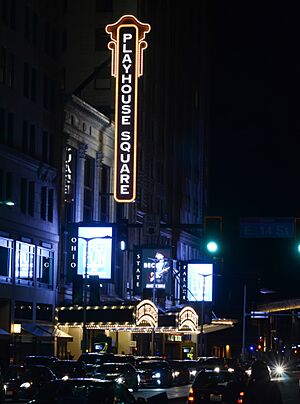
What Remains and What's New?
Eight houses from the old "Millionaires' Row" era are still on Euclid Avenue. These include the Samuel Mather and Howe mansions. Cleveland State University now owns and uses these buildings. One of the last mansions to be torn down was the Lyman Treadway Mansion in 2002. It had been part of the Cleveland Museum of Health since the 1930s.
The Euclid Avenue Historic District is a special area. It is listed on the National Register of Historic Places because of its history.
An important invention happened on Euclid Avenue. On August 5, 1914, the American Traffic Signal Company put up a traffic signal system. This was at the corner of East 105th Street and Euclid Avenue. It was the first traffic light ever installed in the United States!
Theaters of Playhouse Square
Euclid Avenue is home to Playhouse Square, a large theater district. Famous theaters there include the Allen Theatre, State Theatre, Ohio Theatre, and Palace Theater.
Recent Changes on Euclid Avenue
In April 2006, parts of Euclid Avenue were closed for filming. A scene from the movie Spider-Man 3 was shot there. No major movie stars were present, but many people came to watch. The filming involved explosions and cars being destroyed. The street was made to look like a street in New York City. It had fake magazine stands and walls covered with posters.
The Greater Cleveland Regional Transit Authority worked to improve the western part of Euclid Avenue. This was part of the Euclid Corridor Transportation Project, which finished in 2008. The HealthLine is a special bus line that now runs from Public Square. It goes to the Stokes Rapid Transit station in East Cleveland. This station is the end of the Red Line train route. The improvements also led to new buildings and projects. By 2009, over $3.3 billion worth of new projects were built or planned along the street.
What Roads Does Euclid Avenue Connect To?
Euclid Avenue was first known as part of the Buffalo Stage Road. Over time, it has had different road names.
- Before 1923, parts of Euclid Avenue were called Inter-county Route 2 and Main Market Road VI.
- In 1923, when Ohio started its modern road numbering system, State Route 2 and State Route 15 were on Euclid Avenue. This was from Public Square to Mayfield Road. SR 2 continued from there to Willoughby.
- In 1926, SR 2 was moved to Superior Avenue. This left Euclid Avenue as only SR 15 in some parts.
- In 1927, U.S. Route 20 took the place of SR 2 on Euclid Avenue. U.S. Route 322 replaced SR 15.
- In 1932, U.S. Route 6 was added to the US 20 part of the road.
- In 1950, US 322 moved to Superior Avenue and Chester Avenue. It still runs on Euclid Avenue from Chester Avenue to Mayfield Road.
- In 1967, US 20 was moved to Euclid Avenue from Public Square to Superior Avenue in East Cleveland.
Important Places on Euclid Avenue
Public Square Area
- 200 Public Square Building (built 1982–1986)
- Soldiers and Sailors Monument (built 1894; updated 2008–2010)
East 4th Street District
- Cleveland Arcade (built 1890)
- PNC Bank Guardian Bank Building (built 1890)
Nine-Twelve District

- The 9 Cleveland
- City Club Building
- PNC Center (built 1980)
- Cleveland Trust Company Building (built 1908; now a Heinen's Grocery Store)
- Huntington Bank Building (built 1922–24)
- The Schofield
East 12th Street Area
- Statler Arms Apartments
- Union Club
- Halle Brothers Co. Building (now studios for radio stations)
- Sterling Lindner Davis
East 14th Street Area
- The ideastream Idea Center (studios for TV and radio stations)
- Wyndham Hotel
- U.S. Bank Centre
- GE Chandelier, the world's largest outdoor chandelier
Playhouse Square Theaters
- Hanna Theatre
- Allen Theatre
- Ohio Theatre
- State Theatre
- Palace Theater
- Keith Building
East 17th-East 24th Street Area
- Innerbelt
- Maxine Goodman Levin College of Urban Affairs
- Cleveland-Marshall College of Law
- Washkewicz College of Engineering
- Fenn Tower
- Trinity Cathedral
- The Edge On Euclid
Cleveland State University Campus
- CSU School of Communication
- CSU Student Center
- CSU Main Library/Rhodes Tower
- Main Classrooms
- CSU Science Building
East 30th Street Area
- WEWS-TV
- Cuyahoga Board of Elections
- Applied Industrial Technologies
- Karpinski Engineering
Midtown East 55th Street Area
- Agora Theatre and Ballroom
East 105th Street Area
- Cleveland Clinic Campus
- University Circle
- Severance Hall
- Cleveland Museum of Art
- Case Western Reserve University
- University Hospitals of Cleveland
- East Cleveland, Ohio
- Euclid, Ohio
- Wickliffe, Ohio
- Telshe Yeshiva
- Center For Pastoral Leadership (Catholic Diocese of Cleveland Seminaries)


